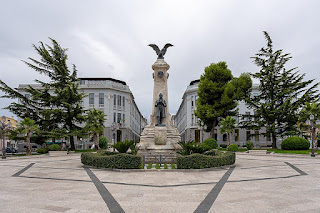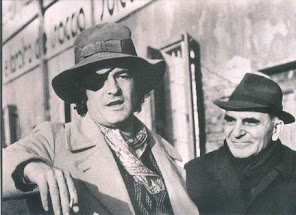Neapolitan who wrote the words to ‘O sole mio
.jpg) |
| Giovanni Capurro wrote many songs but made little money from them |
Giovanni Capurro, a poet and songwriter best known for writing the lyric of the classic Neapolitan song ‘O sole mio, was born in Naples on this day in 1859.
The son of a professor of languages, Capurro was a cultured man who would in time be considered one of the 19th century’s finest Italian poets, yet was never well rewarded for his art. He spent much of his working life as a journalist and died poor.
Capurro grew up in the Montecalvario district of Naples, an area of the city centre that climbs up the hill of San Martino to the west of Via Toledo. Although his first love was writing, and poetry in particular, he was also a talented musician, graduating from the Naples Conservatory after studying the flute. He was also blessed with a good singing voice.
He wrote poetry in both Italian and Neapolitan dialect, both in the form of song lyrics and volumes of poetry. The celebrated actor, Raffaele Viviani, made his first appearance on the stage of an established theatre - the Teatro Perella in Basso Porto - at the age of four, in a sketch written by Capurro entitled Scugnizzo - The Street Urchin.
Capurro published more than 30 lyrics that were put to music, none more famous than ‘O sole mio, which he wrote in 1898, asking Eduardo di Capua, a Neapolitan songwriter and composer, to set it to music. Di Capua, for many credited with writing the melody alone, was later declared only to be the co-composer, after a court in Turin was satisfied that the melody had been an adaptation of one di Capua had bought from another musician, Alfredo Mazzucchi.
The song was presented at the famous Piedigrotta Festival, the music competition in the Chiaia district of Naples that was the launching pad for many famous Neapolitan songs.
 |
| The cover of the first edition of the sheet music of Capurro's 'O sole mio |
Capurro’s other songs included Carduccianelle, N'atu munasterio, Napulitanata, Ammore che gira, Totonno 'e Quagliarelle, 'O scugnizzo, 'O guaglione d' 'o speziale, Lily Kangy, Chitarra mia and 'A chiantosa.
Yet he received little money for any of them. He sold the rights to ‘O sole mio, to a publishing house for a one-time fee.
Had he any notion of how famous it would become - it has featured in the repertoire of such illustrious tenors as Luciano Pavarotti, Enrico Caruso, Andrea Bocelli and Beniamino Gigli - he would surely have negotiated a royalties deal.
As it was, he did not write with the aim of making money, merely to indulge his own fascination with the art. Early in his writing career, his poem Carduccianelle adapted to Neapolitan the evocations of Classical world employed by Nobel Prize-winning poet Giosuè Carducci a few years earlier in his Odi Barbare. Neapolitan readers regarded it more as a curiosity than as a book of true poetry.
Capurri delighted in spending his evenings in salons, where he would sing, play the piano and amuse audiences with his imitations of famous performers, but made his living as a journalist.
Beginning with the socialist periodical La Montagna, he then wrote for the Naples political newspaper Don Marzio, before joining the staff of the daily newspaper, Roma, in 1896, working initially as a reporter before becoming a theatre critic.
Married with three children, Capurro died in Naples in 1920 at the age of 61.
 |
| The upper parts of Montecalvario offer some stunning views over the city of Naples |
The Montecalvario neighbourhood is the area of central Naples that includes the northern part of the Quartieri Spagnoli - the Spanish Quarter - the network of teeming streets that was built in the 16th century to house Spanish soldiers after the armies of Ferdinand II of Aragon had defeated the French to take control of the city. The main part of Montecalvario is to the west of Via Toledo, one of the city’s main shopping thoroughfares, which follows a long, straight course from Piazza Dante, through Piazza Carità before ending at Piazza Trieste e Trento, near Piazza del Plebiscito. The bustling Mercato Pignasecca offers a chance to experience shopping with the locals, while a climb up to Corso Vittorio Emanuele, the street which borders the upper part of the neighbourhood, is worth it to find a vantage point for spectacular views over the city.
 |
| The church of Santa Maria di Piedigrotta, which is the origin of the annual Festa della Madonna |
Piedigrotta is an area that forms part of the Chiaia district of Naples, close to the port at Mergellina. It takes its name from its location at the foot of a tunnel - "ai pedi grotta" - built into the Posillipo hill in Roman times. It is best known for its annual Festa della Madonna di Piedigrotta, an occasion of fireworks and parades that has been staged every September since the 1800s. For many years, the celebrations included an annual song competition, the Neapolitan Song Festival, which showcased the city’s tradition of street musicians entertaining audiences with folk songs in Neapolitan dialect. It did much to popularise Neapolitan Songs as a genre, challenging the city’s most talented lyricists to excel. The competition launched in 1890 and became enormously successful, but was suspended in the 1960s because of repeated public order incidents as crowds got out of control. There have been a number of attempts in recent years to revive the contest but it has yet to be reinstated as an annual event.
Also on this day:
Catania celebrates the Feast of Saint Agatha
1578: The death of painter Giovanni Battista Moroni
1887: Verdi’s Otello premieres in Milan
1932: The birth of football coach Cesare Maldini
1960: Movie La dolce vita shown in public for first time
1964: The birth of footballer and coach Carolina Morace







-panorama_novembre_2019.jpg)



.jpg)
_-_Facade.jpg)






















